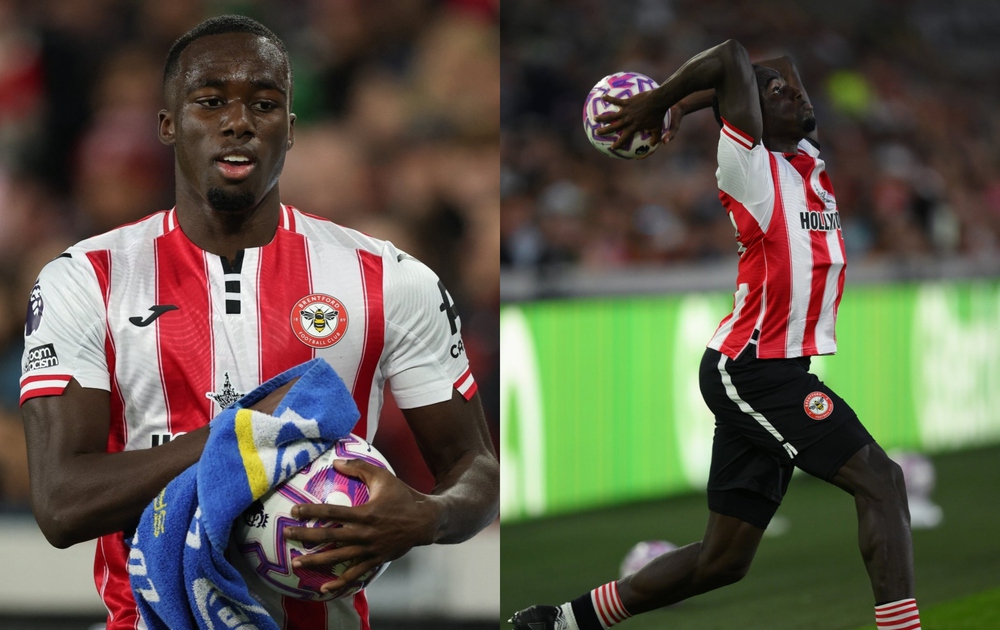Brentford is the "King of Throw-ins"
The throw-in weapon helped Brentford overcome Liverpool last weekend. If Arsenal is known for their dangerous corner kicks, Brentford is showing they are the "experts" in throw-in plays.
Throw-ins used to be a tactical weapon Rory Delap employed to shake up the Premier League since Stoke’s promotion in 2008—creating disorder by throwing the ball straight into the penalty box. Today, this tactic appears more frequently in England’s top division, with Brentford emerging as the team that uses it most effectively.
Throw-ins are Brentford’s "weapon"
For the 8th time since the start of the 2024/25 season, Brentford scored from a throw-in to open the scoring against Liverpool. Michael Kayode’s throw reached deep into Liverpool’s penalty area, Kristoffer Ajer headed it on, and Ouattara finished at the far post past Giorgi Mamardashvili.
Before becoming head coach, Keith Andrews was Brentford’s set-piece coach. As a defensive midfielder, he often faced Delap’s long throw-ins—“not a pleasant experience,” according to Andrews. He even revealed that the throw-in factor was part of the reason Brentford signed Italian right-back Kayode from Fiorentina in January.
Last season, long throw-ins were a fixed part of their tactics: They not only scored 5 goals but also created 48 chances with a total expected goals (xG) of 7.2.
Another contributor to Brentford’s dangerous throw-ins is throw-in coach Thomas Gronnemark, who consults for them and supports many European clubs, including FC Midtjylland—Brentford’s sister club until 2023—which has also scored many goals from throw-ins this year.
Marc Ortiz Esteban, who formerly analyzed Brentford’s set pieces, shared a secret with Sky Sports: “Even if we have 10 throw-ins in a match without creating chances, we keep going because we understand its long-term value.”
Brentford consistently generates the best throw-in opportunities in the Premier League. Part of the reason is that they have many players trained in this skill. Wing-back Michael Kayode is Brentford’s main throw-in threat due to his long distance, but they also rely on Ethan Pinnock, Mathias Jensen, and Kevin Schade as alternatives. Midfielder Frank Onyeka was the throw-in specialist in the match against Villa.

Countering Brentford’s throw-ins is no easy task
Why is Brentford so good at throw-ins?
“In the squad, they have about 5, 6, or 7 world-class throw-in specialists. I created them,” said Gronnemark.
The variety of throw-in players in Brentford’s lineup is remarkable. Pinnock and Kayode are tall defenders over 1.8 meters, so it’s no surprise they throw far. But Jensen is one of the smallest and most technical players, while Schade is the fastest and also effective with his arms.
“Ethan Pinnock exemplifies the tall throw-in type. He has long arms and an advantage. Schade is the fast type. Many players have fast-twitch muscle fibers, so they explode on the field and also when throwing the ball,” Gronnemark confirmed.
Gronnemark stated: “If you can throw around 34 meters in a test, that’s world-class. It will reach the penalty spot on the ground or the near post in the air. If a player can’t throw into the 5.5-meter area, you shouldn’t use them.”
“If you have 3 or 4 players good at heading and one of them throws the ball, you have a big advantage,” Gronnemark added.
Throw-in tactics include creating space, using blockers to hold off opposing defenders, or making runs. Another factor is the second phase of the throw-in. For example, Hickey’s goal against Villa resulted from Brentford’s quick reaction after the ball was cleared from a throw-in.
“What’s important is how you occupy space for the second balls. Usually, scoring directly from the first touch of a long throw-in is difficult, so positioning players in the right area is key,” former analyst Esteban explained.
Although considered an "old weapon," throw-ins have become a potent and effective tactic. England coach Thomas Tuchel declared that throw-ins are back in vogue. It wouldn’t be surprising if Brentford continues to score from throw-ins in upcoming matches.


Wonderfulshortvideo
Ronaldo brace 😮💨🔥


neymar 2014 world cup neymar edit


The Lionesses feeling the love from Grace Clinton 🤗


Early warm up 😅


User PANDATV has posted a video.


Who starts on the wing for England?


Such good value.. don’t miss out and use my Code: dzw5838 for








 Links
Links
 Contact
Contact
 App
App


